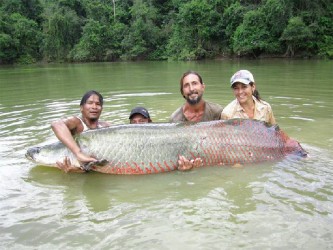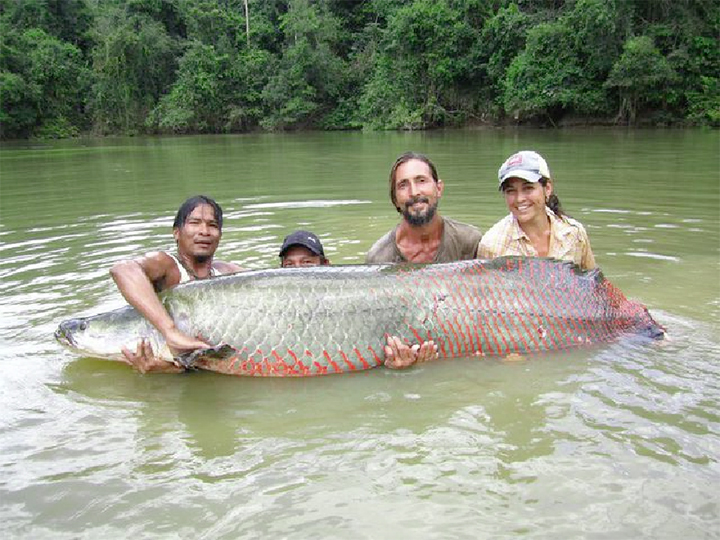By Dr. Lesley de Souza
Dr. de Souza holds a two-year postdoctoral research position at the Chicago based Shedd Aquarium, that continues Shedd’s research in Guyana’s North Rupununi region, where intensive fieldwork is needed to assess and protect the area’s rich aquatic biodiversity. Dr. de Souza’s work will help conservation managers understand the role that Rupununi wetlands play in supporting fish diversity, which in turn will help establish scientifically sound fishing regulations. She also plans to identify and monitor the migratory routes and nesting sites of arapaima, one of the largest freshwater fishes in the world. Additionally, Dr. de Souza will study the physiological impacts on arapaima that are captured by sport fishermen. Prior to joining Shedd, Dr. de Souza spent nine years studying freshwater fish and lizards in Guyana and other parts of Latin America. Dr. de Souza has authored several articles in the New York Times ‘Scientists at work’ section. This column first appeared in the National Geographic.
The blazing sun of the tropics beats down on my sensitive Chicago winter skin as I motor down the Rupununi River. Arriving at the landing in Rewa Village, I am met with the smiles of familiar faces. I have been doing arapaima research based out of Rewa Village in the North Rupununi of Guyana for the past year and a half. The village has become a second home and the people have become dear friends, colleagues and mentors.

The relationships I have developed with Rewa and other communities are critical to this research. Occurring in Rewa is something that is a glory to experience as a conservation biologist – conservation happening at the local level. The village first initiated efforts to protect their natural resources by banning commercial harvest of arapaima and other wildlife about a decade ago. These efforts were met with challenges, as many locals were accustomed to relying on this this as an important source of income. The development of an eco-lodge and nascent sport fishing business has heartened their pursuit in conserving wildlife. Here, the tourism is on the small scale, but it has been providing the community with a direct benefit by increasing the awareness of the incredible biodiversity and a sustainable stream of revenue for its people. Additionally, arapaima populations have rebounded during this time, making Rewa River drainage one of the densest in the country.
High population densities have made Rewa River an ideal location to research movement patterns of arapaima. Assessing their migration routes enables us to determine critical breeding and feeding habitats in the dry and wet seasons. In addition to population monitoring efforts led by the North Rupununi District Development Board (NRDDB), the research will inform governance for revisions to the arapaima management plan.
Among the largest freshwater fish in the world, arapaima serve an important role in ecosystem functions of the rivers and wetlands they inhabit. Therefore, they have great potential as a flagship species for Amazonian ecosystems because their protection requires conservation of freshwater and terrestrial habitats of high biodiversity. Using radio-telemetry to track arapaima is new for this species. Since the inception of this project, Amerindian villagers have assisted and helped guide the research. Their wealth of knowledge of the surrounding environment and wildlife continues to be vital for the success of this work. Their in-depth understanding of arapaima’s behavior enabled us to use radio transmitters to help track 28 arapaima in the dry season.
Over the course of the season we were able to easily track the arapaima in the ponds, oxbow lakes, inlets and river. They hovered in a general area not far from where we tagged them. We were also able to identify many individuals’ nest sites. Once the wet season was underway they began moving into the flooded forest and then, just like that, we lost them! The waters came up fast and they bolted.
For most of the wet season our crew tirelessly cut trails through the flooded forest looking for the tagged arapaima. Many nights we wondered if we would have high ground to set up camp, not to mention the long days with steady rainfall. We were looking for a needle in a haystack in the expansive flood forests of Guyana. Despite our best efforts, we could only relocate five arapaima.
As the waters receded in the beginning of the following dry season, I saw several fish species moving down river, including arapaima. This filled us with anticipation for our first day tracking and what we might find. As we approached the first pond I turned the receiver on and heard the fuzzy white noise that signifies no radio is nearby. We began paddling across the pond and there was the faint sound of a signal. In the second dry season we found that most of the tagged arapaima were returning to the same ponds and many to the same nests. These emerging patterns are exciting, but it is too soon to elucidate overall migration patterns of arapaima until we have a couple more field seasons under our belt.
Fly-fishing anglers have also participated in arapaima conservation in Rewa by PIT (Passive Integrated Transponders) tagging and measuring all fish they land. This is a great help because PIT tagging arapaima enables us to monitor movement patterns of arapaima long-term. PIT tags, about the size of a rice grain, contain a unique barcode that lasts the life of the fish, further increasing the scope of this work in Rewa because villagers will be able to monitor tagged fish beyond the life of this current project and long after I leave Rewa. The anglers also help increase awareness of this spectacular endangered species found in the rivers of Guyana, expanding local conservation efforts to a global scale.
Change in the Rupununi is occurring at an unprecedented rate, generating a sense of urgency for swift action to protect the incredible diversity in the forests, rivers and savannas. What occurs at the local level amongst the inhabitants of these wild places supporting arapaima will have everlasting effects. The Amerindians of Rewa are on the forefront of conservation with generations in the village growing up with a mindset to protect their natural resources. Additionally, social pressures to change from an extractive to a conservation lifestyle are permeating to other nearby villages. I have been enhanced as a person and certainly shaped as a biologist working closely with the Amerindians of Guyana.

